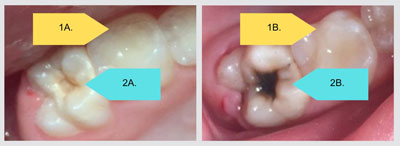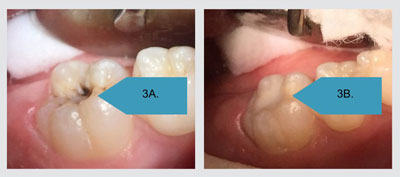Silver diamine fluoride
Silver diamine fluoride (SDF) is a painless, topical liquid painted onto the teeth to prevent cavities from forming on healthy teeth AND to stop or slow decay if cavities are present.
SDF is simple and fast to apply and can be brushed right over tooth decay or on healthy teeth as prevention against decay. There is no need for injections of local anesthetic, drilling or filling, saving the patient time, pain, and money.
Many people can benefit from SDF, but it is especially helpful for people who have trouble sitting for long periods of time to allow the dentist to place a traditional filling.
Video on SDF
English SDF video
Spanish SDF video
+ What is SDF?
SDF (or Silver Diamine Fluoride) is a pain-free way to stop or slow down tooth decay and prevent new decay from starting. It’s a liquid made up of fluoride and silver ions and it's very good at killing the bacteria that cause cavities.
When painted onto a cavity, its antimicrobial properties make the tooth harder and slow down or stop the cavity from growing.
When applied to healthy teeth, SDF absorbs into the tooth, offering strong protection. SDF has comparable results to dental sealants at preventing cavities in healthy teeth.
+ Why use SDF?
SDF is an antimicrobial liquid that can be applied with a soft brush (no drills or needles). It's fast, affordable, and pain-free. SDF can prevent cavities in healthy teeth and slow down or stop existing decay.
Because SDF keeps cavities from getting worse, sometimes it is the only treatment needed (if the cavities are small).
+ What is the treatment like?
SDF is painted onto a cavity with a small brush and takes less than five minutes. The good news is that it does not hurt and does not require drilling or injecting anesthesia. It has a metallic taste and occasionally causes mild irritation to the gums that will go away in a few days. For maximum effectiveness, additional treatments of SDF are recommended.
+ Is SDF safe?
Very safe, according to the evidence-based clinical guidelines of the American Academy of Pediatric Dentistry (AAPD). SDF has been used in Japan for over 40 years and in Australia and China for over 10 years. Most important, it can postpone or even prevent the need for sedation or general anesthesia, especially for very young patients.
+ You should not be treated with SDF if:
- You have a silver allergy
- Cavities are so large that they involve the nerve of the tooth
- There are open sores in the mouth
+ Does SDF work to stop tooth decay?
- Clinical studies show that SDF can slow or stop around 70-80% of cavities. Teeth treated with SDF need to be checked by a dentist at least every six months to make sure the tooth decay has been stopped.
+ Is it true SDF turns teeth black?
- Only ACTIVE cavities treated with SDF turn black. The healthy part of the tooth and other healthy teeth in the mouth will not stain. This color change is permanent, lasting the life of the tooth. If the cavities are on the back teeth, it is barely noticeable. If the cavities are on the front teeth, it can be very noticeable.
- The black is a sign of success that the decay has been slowed or stopped.
- Fillings can be placed on top of discolored teeth to cover the SDF staining. “SMART fillings” can cover SDF stains without drilling or injections.
- If SDF touches the lips or skin, it will leave a temporary “henna-like” stain for a few days.
+ What are “SMART” no drill, no injection fillings?
- SMART” fillings or Silver Modified Atraumatic Restorative Technique fillings, are a no drill, no injection way of treating decay. In SMART, a carious lesion (cavity) is first treated with SDF and then several weeks later restored with a glass ionomer sealant. The SDF stops the decay, without removing any tooth structure and is restored with a glass ionomer sealant.
- The added benefit is that the glass ionomer sealant will also mask the black stain caused by the SDF.
+ Why treat cavities in baby teeth?
- Cavities on children’s teeth can grow very fast and cause pain and infection. Cavities are contagious and can spread to other teeth in the mouth if not addressed quickly.
- Cavities can get so bad that the nerve of the tooth can become infected leading to serious infections in the body.
- Baby teeth hold space for the proper placing of the permanent teeth. If a baby tooth is lost too early, it may mean a crooked smile in the child’s future.
+ What can I do at home to prevent cavities?
- Keep teeth clean by brushing with fluoride toothpaste after breakfast and before bed.
- Cut down on how often you eat sugary food and drinks, and
- Visit your dentist every six months.
 1A. Healthy tooth before SDF 1B. Healthy tooth after SDF
1A. Healthy tooth before SDF 1B. Healthy tooth after SDF
2A. Cavity before SDF 2B. Cavity after SDF
SDF slows down or stops cavities.
Healthy teeth that are treated with SDF look no different and do not stain.
Photos courtesy of Dr. Jeanette MacLean
 3A. SDF slows or stops decay 3B. SMART filling can cover SDF stain
3A. SDF slows or stops decay 3B. SMART filling can cover SDF stain
A “SMART filling” can be done at your dentist office to cover SDF stain and avoid drilling. Ask your dentist for “minimally invasive dentistry.”

